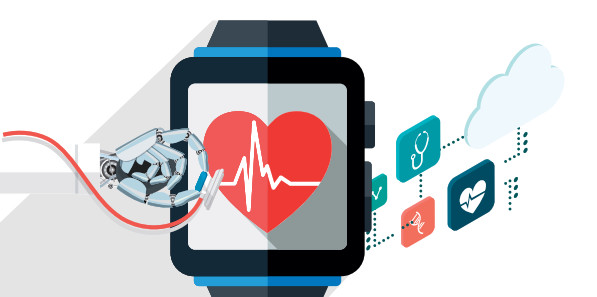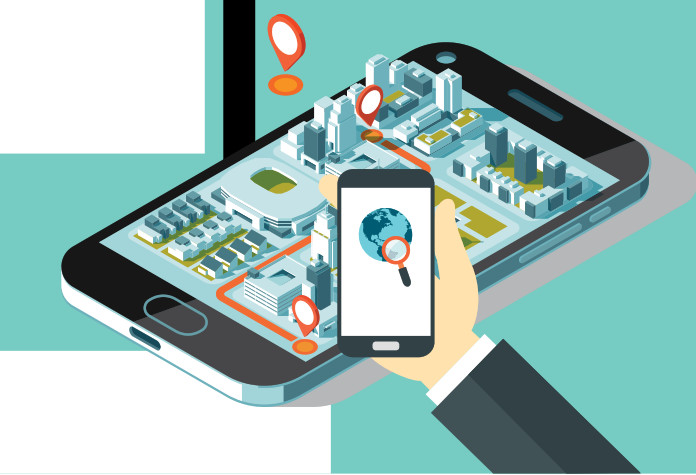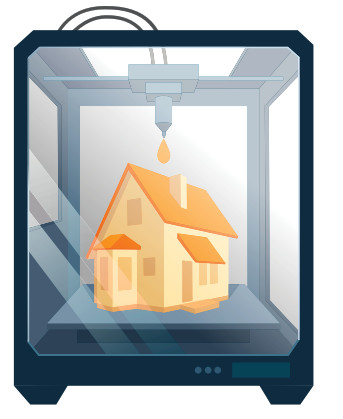It seems like it was only yesterday that we were still sending letters and driving manual cars.


It seems like it was only yesterday that we were still sending letters and driving manual cars. Today, the advent of technology has practically revolutionised almost every aspect of our lives and yet it begs the question: What will tomorrow bring?
Imagine waking up to a new day. A smart alarm clock gently awakens you precisely at the end of your sleep cycle, following which you check your smart watch to ascertain the quality of your sleep. You ready yourself for work, while the virtual assistant on your smart speaker reads you the latest news, and weather and traffic conditions, as you brush your teeth.
Freshly brewed coffee from the automated coffee machine, prepared just the way you like it, awaits you and you grab a cup before work. As you are about to head out of the door, a drone from the logistics company drops off a package just in time. You are scheduled to reach the office at 9am and you get some work done on the commute, thanks to your self-driving car.
The foundations for this futuristic reality are already present. The world today is one that will hardly be recognisable by tomorrow. Where convenience and efficiency reign, the virtual – or at the very least, the augmented – impinges on the real. Human interactions are done over social applications.

SMART HOME DEVICES
Many have dreamed of living in homes where mundane tasks are all automated and can be outsourced to a device, allowing us to exercise control by voice. Today’s smart home is available to the mass market, with products like Amazon Echo and Google Home that make it easy to manage everything at home on a single interface.

ARTIFICIAL INTELLIGENCE
The buzz and interest surrounding AI has built up tremendously, as it has the potential to reshape entire businesses and is expected to reach into many aspects of our lives. There are far-reaching uses for AI that will impact the finance and banking sector, self-driving vehicles, news reporting and many other disciplines.
A large proponent of this change involves businesses that incorporate AI applications into strategic and organisational development. In the age of AI, we are able to sift through large volumes of data within minutes. While the man on the street worries that AI will take over jobs, the reality is that it will help augment those roles, as repetitive tasks can be automated, allowing humans to focus on complex problems.
An example would be Adext, a platform that automates digital advertising processes, saving businesses hours on mechanical tasks. Industrial use of AI can be seen in General Electric’s efforts to build an AI workforce to monitor aircraft and locomotive engines to predict failure and conduct maintenance work. AI is also being used to keep us safe from cyberattacks. Start-ups such as Darktrace have developed AI that can conduct behavioural analytics to automatically detect abnormal behaviour.
AUGMENTED AND VIRTUAL REALITY
There is a reality beyond our own and technology is making it possible to explore it. More than just tools used for video games, augmented reality (AR) and virtual reality (VR) technologies are finding their way into the telecommunication and manufacturing industries, where they help bridge the gap in communication with remote areas.
Major tech companies like Facebook, Google, Samsung and Microsoft see value in VR. Each has developed its own interpretation of the next-generation VR and AR headsets that they hope will be the next big computing platforms. AR, in particular, has had a huge transformative impact on the healthcare industry, with solutions such as Microsoft’s Hololens used to train medical professionals. VR has also been effectively used in treatment for a variety of ailments, including post traumatic stress disorder, anxiety and depression.
Locally, the Home Team has begun experimenting with VR tech to create realistic training environments. This reduces safety risk through physical training, and improves efficiency by reducing the need for setup of training equipment.
From a more commercial perspective, Ikea has launched an AR application that allows potential customers to use their smart device to “place” 3-D models of furniture items in their homes and see how it looks, before buying it.
Similarly, Facebook plans to work with businesses to use AR technology to show off products via Messenger.

HEALTH SENSORS
Wearable health sensors are stepping in to change behaviour by encouraging users to lead healthier and more active lifestyles. Beyond that, health sensors are also allowing doctors to monitor patients in the comfort of their homes, instead of requiring them to stay in a hospital. Smart watches that monitor a patient’s heart rate and level of physical activity are able to send health data over the Internet to doctors and even alert them in the event of an emergency - making healthcare from home a possible reality in the near future.
5G TECHNOLOGY
The power of connectivity has the potential to fast-track innovation and drive economies forward. The coming advent of mobile 5G, also known as fifth-generation networks, could prove to be game-changing.
The average 4G speed is about 18Mbps, while 5G speeds are expected to go up to 1Gbps, which is quicker than fibre broadband. Telecommunication companies around the world are already testing 5G in cities, while hardware manufacturers like Nokia and Qualcomm are creating 5G prototype devices that would eventually make their way into the tablets and smartphones of tomorrow.
5G promises to be the connective tissue that binds emerging technologies such as the Internet of Things devices to power smart cities, autonomous vehicles and delivery of VR content to consumers. In Singapore, major telcos such as Singtel and Starhub have already started 5G trials, with promise of the fifth-generation mobile network technology to be available by next year.

SELF-DRIVING CARS
The idea of self-driving cars sounded preposterous a few years ago but it is becoming a reality, sooner than we think. Self-driving cars could make the commute to work less stressful as it eliminates the need for drivers to be watchful of traffic conditions amid rush hour traffic. Such a vehicle is the result of a mix of machine learning algorithms working together with car sensors and software to navigate a variety of real-world settings.
Self-driving cars, built by companies like Uber, Tesla and Waymo, are already being tested on a number of highways in the United States. The technology, however, is far from perfect; in March last year, a self-driving Uber car fatally struck a pedestrian. This calls into question the readiness of these machines for real-life situations. It also raises ethical concerns – should the vehicle prioritise the safety of its passengers or pedestrians? At home, intensive trials are under way for such autonomous vehicles, with key players such as the Agency for Science Technology and Research, the National University of Singapore, and Nanyang Technological University leading the pack.

VIDEO ON DEMAND SERVICES
Video on demand services that include the likes of Netflix, Iflix, Hulu and Amazon Prime Video have exploded in popularity, due to better access to the Internet, improved broadband speeds and cheaper data. The focus for video content is no longer the TV in the living room but the smart devices in consumers’ pockets.
With deep pockets, providers like Netflix have moved beyond distributing content and are producing their own original high-quality shows. To an extent, South-east Asian players like Iflix and home-grown Toggle are following suit, but they are also exploring live streaming content like news and sporting events. Needless to say, the battle for eyeballs and screen time is definitely hotting up, as entertainment-hungry viewers look towards more localised content and not just big Hollywood productions.
INTERNET OF THINGS
The barrier between physical and virtual things is slowly being broken down, thanks to intelligent sensors that are all around us. These devices are all connected to a unified network called the Internet of Things (IoT). Tech companies, big and small, are trying to make their mark on the IoT field, including Intel, Qualcomm, IBM and Microsoft.
Statistics from Statista estimate that there would be over 75 billion IoT devices by 2025 and the market is estimated to be worth more than US$1 billion (S$1.4 billion) annually from 2017 onwards. While IoT is often associated with smart consumer devices, it promises to bring greater efficiency and productivity to businesses too. For instance, Zebra Technologies sells trackers that use radio frequency to tag items in warehouses, offering real-time visibility of inventory. Other applications include helping sports teams improve their performance – American football players in the National Football League, for example, use radio-frequency identification chips to track their movements across a field, to help coaches formulate better strategies.
SMART CITIES
As more people live in cities – the UN estimates that 60 per cent of the global population will reside in cities by 2030 – there is a need to make these places smarter, more efficient and sustainable. But the city of the future is closer than you think, as cities now are already adapting to their surroundings and inhabitants. Within these smart cities, municipal services like public transport, healthcare and safety can be delivered on time with minimal wastage.
Cities across the world, including those in the United States, Europe and China, are collecting data using thousands of sensors and nodes on public infrastructure, and utilising data analytics to develop integrated services that reduce waste, congestion and improve public safety. Shining examples of smart cities of the future include Amsterdam, Hangzhou and Singapore.
For Singapore, the vision of becoming a smart nation is actualised even in our housing – with the Housing Development Board’s first town, Tengah, to have town-wide smart technologies from the outset. Among the features available at Tengah is a centralised, energy-efficient cooling system – a first for public housing in Singapore. With this, each household will be cooled in an eco-friendly manner while saving on costs, as there’s no longer a need to install and maintain external condenser units – making it win-win for both residents and the environment.

3-D PRINTERS
3-D printing technology has advanced since its use by hobbyists, to be commercially applied to construction and the medical field. Entire buildings can now be 3-D printed, making affordable housing a reality for the homeless and providing shelter for victims of natural disasters. This is likely to shake up the construction industry as the process of building is no longer susceptible to labour cost or time constraints. Doctors are able to harness 3-D printing technology to plan for complex surgery, create customised prosthetic limbs for amputees and may even, one day, print organic human tissue to replace damaged organs.
BLOCKCHAIN TECHNOLOGY

FACIAL RECOGNITION
Facial recognition technology has become increasingly common in everyday life. It is used in security by way of biometrics on smartphones like the iPhone X, Samsung Galaxy S9 and Oppo Find X to unlock the devices in less than a second.
At the same time, it is present in companies like Amazon, which is providing assistance to law enforcement agencies through the use of its cloud-based face recognition service Rekognition. Within the marketing and retail space, some companies like KFC in America and Alibaba in China are testing face recognition payment solutions.
NomadX in Plaza Singapura also uses such technologies to enhance a shopper’s experience. An optional sign-up and facial recognition pairing is provided at kiosks throughout the twostorey space. This allows customers to subscribe to and receive tailored advertisements and recommendations, as an algorithm will personalise their searches and interests.
For the traveller, Singapore’s immigration points are also implementing facial recognition to ease bottlenecks. At Changi Airport’s Terminal 4, it makes redundant the need for manual checking by staff. Meanwhile, immigration points at the Causeway are conducting trials for such technology. It won’t be long now before crossing the border becomes much more convenient.

CITY FARMS
As food security becomes an increasingly pertinent issue as a result of climate change, countries scramble to ensure that they have enough food to sustain themselves. In land-scarce Singapore, the key to farming is to grow produce – whether vegetables or fish – skywards. Harvests that previously needed a vast plot of land to yield, now require only a fraction of the space. For local vertical farm Sustenir, the same hectare can yield 2,100 tonnes of harvest, instead of 140 tonnes on a traditional farm.
Plus, an indoor environment eradicates many of the problems with our equatorial climate, which is unsuitable for the growth of most plants. Adjustments can be made to carbon dioxide concentration and the wavelength of light provided – which can affect the taste of produce. (This is not to be confused with genetically modified foods.)
The process has allowed Sustenir to produce a sweeter kale – as most Singaporeans prefer it – instead of a bitter one. The technology also allows for the cultivation of non-native crops otherwise available only via importing, leading Sustenir to be crowned the first local vertical farm to successfully grow strawberries.
WIRELESS CHARGING
The rising use of smartphones, tablets and wearable devices means that consumers are carrying more gadgets on them. Wireless charging technology removes the hassle of managing multiple charging cables. This ease of charging is set to become an integral part of the consumer experience, as people start to ditch physical chargers. Many items, from alarm clocks and mousepads to smart furniture, are embedding wireless charging so they can power up devices automatically.
Local start-up Transfer Fi has made possible wireless charging over long distances. By using radiofrequencies as a conduit for wireless power transfer, the company has radically changed the game for tech users. It is looking to go into production by the end of this year.

DRONES
Think of drones and images of buzzing, four-bladed plastic devices hovering over an open field come to mind. For the most part, these drones have been limited to die-hard hobbyists, movie makers and the military.
But today’s popularity in drones is fuelled by just how affordable and accessible they are. Increasingly, their use in commercial and research operations has been considered and may be implemented. Yes, your next pizza or delivery from Amazon could be delivered by a drone. Airbus has been testing such technologies for its Skyways parcel delivery drone. While these parcel delivery trials have yet to commence, it has managed to complete ship-to-shore deliveries and is the first to do so under real port conditions.
While that reality may take place only in the future, we are getting there. In the meantime, one can find drones being used to monitor the yield of crops on farms and acting as the eye in the sky for law enforcement, in terms of surveillance or to monitor emergency responders during natural disasters. The Singapore Police Force has also just seen the launch of multiple drone-carrying vehicles for public safety and national security.
TEXT JINN XIUNG & NICHOLAS KOO























